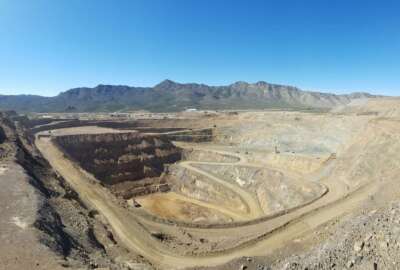

Biofuel will be part of the country's energy future - that's why the Energy Department's ARPA-E is spending some $35 million in grant dollars to improve the eff...
Best listening experience is on Chrome, Firefox or Safari. Subscribe to Federal Drive’s daily audio interviews on Apple Podcasts or PodcastOne.
One way or another, biofuel will be part of the country’s energy future, especially to power ships and airplanes. That’s why the Energy Department’s ARPA-E is spending some $35 million in grant dollars to improve the efficiency of making this class of fuel. For details, the EcoSynBio program director David Babson joined Federal Drive with Tom Temin.
Interview transcript:
Tom Temin: Mr. Babson, good to have you on.
David Babson: Good to be here.
Tom Temin: Let’s begin with what you mean by EcoSynBio, the name of the program.
David Babson: Well, the SynBio piece, it refers to the type of techniques that are going to be used to engineer micro-organisms to make the fuels more efficiently. Specifically, they’re going to use synthetic biology to engineer kind of novel pathways and systems to synthesize fuels in a more resource efficient manner.
Tom Temin: Is the energy input into making these types of fuels less than the energy that you get from the resulting fuel, because that wouldn’t seem to be a great prospect otherwise?
David Babson: You’re right. Actually, so the energy that you get in the product is kind of the concentrated form of the energy that was in the biomass. But it is kind of a unique process because what we’re looking to do with EcoSynBio is optimize carbon efficiency relative to energy efficiency. And the reason is, is because in the future, the cost of wasting carbon is going to be greater than the price of avoiding it. And that is to say, as we deploy more wind and more solar, both the cost and the carbon intensity of power is going down. And we need to develop the tools to actually leverage that low-cost low-carbon power to increase carbon efficiency in products. And that’s what EcoSynBio does is develop those new types of technologies.
Tom Temin: And in the final form of this fuel when the Energy Department and ARPA-E mentions aviation, that’s kerosene – is that what the resulting fuel coming out of this whole process will be?
David Babson: In some of the cases, absolutely. So while the program really seeks to make the synthesis process carbon efficient, it really opens up the possibilities for synthesizing a number of different types of energy dense fuels and chemicals, including kerosene types of fuels that could be used in aviation.
Tom Temin: Alright, so tell us about the grant program. This is to do precisely what? Let’s start with what it is you’re asking organizations to come up with if they were to receive a grant.
David Babson: So in this particular solicitation, what we were asking organizations to do is to develop carbon optimized biosynthesis pathways that could accommodate external energy. And because as I was saying earlier, as we deploy more wind and solar, there’s an opportunity to use that low-cost low-carbon power to drive greater resource efficiency. So we wanted to engineer systems that would allow us to use traditional biomass feedstock that is used to produce first generation biofuels, but use additional energy inputs to make sure that that resource is more efficiently synthesized into products. So we were eliciting ideas from universities, startups and other types of entities that could apply for this to come up with strategies to synthesize fuels and chemicals with 100% carbon efficiency. So that was the ask and we’ve got a lot of different proposals. And the final program suite includes both universities and biotech startups and biotech companies to develop these technologies that we’re eliciting.
Tom Temin: We were speaking with David Babson, he’s the EcoSynBio program director at the Department of Energy’s ARPA-E. And what is the status now? The grants are out and what is the output that you’re expecting at some point down the line?
David Babson: So we’ve made the announcements to the teams that are being awarded. We are negotiating the final awards, and we’re planning to kick off the program in September. Ultimately, what we’d like to see within three years are end-to-end pathways that are capable of taking biomass resources and biogenic CO2, and converting them to fuels and chemicals and products with 100% carbon efficiency by leveraging low cost low carbon power.
Tom Temin: And once the demonstrations are shown to be successful, what will happen? Will they be patented, and then the patents will be available for licensing? In other words, what’s the ultimate tech transfer plan here for once these carbon neutral technologies get worked out?
David Babson: It really depends on the various teams. We actually have some teams that are going to be developing a kind of component technologies, unique synthetic pathways and other types of biocatalytic platforms. Those things could be patented and sold and licensed in different ways. And then we also have teams that have full end-to-end processes that could be commercialized at the end where they can seek financing to build a new bio refinery that is built on those technologies. So it’s really a number of different tech to market strategies, depending on the specific proposal and team.
Tom Temin: And the main oil and energy producers that you commonly think of that also sell their refined fuel to shippers and ship operators and airlines, and you name it – don’t they have the facilities to pursue this kind of thing on their own? Or is it something that they just figure let’s let the scientists figure it out first?
David Babson: Well, it’s really a supply chain challenge. there’s kind of two types of fuels and chemicals industries, the bio-economy, which is essentially a $16 billion corn ethanol industry has the supply chains coming from that corn feedstock, whereas the oil refiners have petroleum. So they’re kind of parallel in that, yeah they both produce fuels and chemicals, but because the feedstocks are different – the types of technologies that are typically applied to produce products are different. And so there is interest among traditional oil refiners to look at new ways of producing fuels and chemicals. But for now, these technologies are pretty high risk. And that’s why ARPA-E is investing in them to kind of take down some of the barriers so that they will be attractive to well financed entities to pick them up and deploy them.
Tom Temin: Sure. And just to be clear, the feedstock for the types of processes you’re looking at with this program are not corn, but other types of biomass.
David Babson: Not necessarily corn, it could include other types of biomass. But we’re not limiting the use of corn as a feedstock, because the actual technologies that we want to come out of this program focus on the biochemical mechanisms by which the feedstock is converted. And so we’re almost agnostic as to where the starch or sugar or CO2 input comes from, in developing those technologies.
Tom Temin: Right. So in other words, the process is further upstream than the feedstock, and the feedstock will produce what it produces, depending on what it is that is refined into into the final fuel.
David Babson: That’s right, the refining process can accommodate any number of different feedstocks.
Tom Temin: Alright. And just briefly, what does this refining process tend to look like?
David Babson: It tends to look like a fermentation, like the traditional – people are familiar with the production of ethanol for beer and wine, that evolved natural pathway is what we are using as a starting point. And then we are using synthetic biology to engineer the microorganisms that carry out those processes to allow them to be more carbon efficient, and to produce more product from less input.
Tom Temin: Alright. And what’s the timeline here? You said the program will launch in September? Is it going to take a year do you think or six months to come up with some processes?
David Babson: There are two sets of projects in the program, some are 24 months, and some are 36 months. So within two to three years, we’re anticipating some different types of product outputs, whether those are in individual component technologies that are licensed or end to end processes. The timeline is is short and very ambitious, so we’re expecting to see things within three years.
Tom Temin: David Babson is EcoSynBio program director at the Department of Energy, specifically the ARPA-E office. Thanks so much for joining me.
David Babson: Thanks for having me.
Copyright © 2024 Federal News Network. All rights reserved. This website is not intended for users located within the European Economic Area.
Tom Temin is host of the Federal Drive and has been providing insight on federal technology and management issues for more than 30 years.
Follow @tteminWFED


